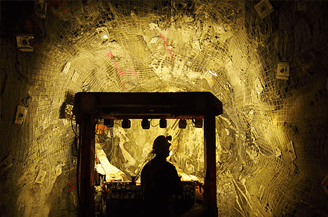
There's no getting around the fact that 2013 was a lousy year for precious metals, performance-wise. Gold fell 28%, while silver plunged 38%. And prices haven't recovered yet in 2014.
A superficial analysis would take the price moves as a starting point and look for news items that seem to explain them. But underneath the surface, the global market for physical gold and silver gained fundamental strength even as spot prices weakened.
The heavy liquidation seen in futures markets and exchange-traded vehicles in 2013 was a one-off event. The paper selling wasn't confirmed by physical selling, especially in the retail bullion market, where demand for Silver Eagle coins hit a record.
Most analyst forecasts for gold and silver call for prices in 2014 to be roughly flat. Prices may have some more basing out to do, but with virtually no mainstream analysts bullish, the potential for an upside surprise should be heavily considered. Markets have a way of moving in the opposite direction of prevailing sentiment.
A Rare Opportunity to Buy Gold at Its Mining Cost
Some conventional financial analysts have difficulty valuing unconventional assets such as gold and silver. These pundits complain that since precious metals have no earnings, pay no interest, and carry no credit risk, they must be driven purely by speculation.
Of course, as with any other asset class, metals prices can be pushed around by speculators. But there are ways of gauging whether prices at any given time are fundamentally well supported. One is by comparing current prices with the actual costs of production.
When gold prices are high relative to mining costs, that's one indicator that gold might be fundamentally overvalued – or at least that prices carry some significant downside risk."Gold won't get produced for very long if miners can't do so at a profit."
By contrast, when spot prices are close to the actual costs of production, investors can buy knowing that prices are near something of a fundamental floor. "Gold won't get produced for very long if miners can't do so at a profit".
In 2003, gold production costs averaged less than $200 per ounce. By 2013, it cost an average of close to $1,200 to bring an ounce of gold to market! Many mines can't produce gold profitably at today's prices.
Scotiabank reports the all-in cash costs at some mines are as high as $1,700 per ounce. Scotiabank projects that as miners ramp down or abandon high-cost projects, they will report lower gold production targets for 2014. That means in the months ahead, mining supply can be expected to suffer a drop-off.
There are signs this is happening now. Gold recycling – the category that includes scrap jewelry – is down 158 tons year over year.
And although mining stocks finally had a good month in January, the environment for raising money to build the mines of tomorrow has recently been likened to nuclear winter.
Why $2,500 Gold Would Be Reasonable Today
The silver lining is that these brutal conditions for the mining sector present a great opportunity to buy physical precious metals near their actual costs of production. Historically, gold prices have traded at an average premium of 2.1 times gold's production costs.
Thomson Reuters GFMS estimates the average cost to produce an ounce of gold to be $1,200. Assuming average production costs of $1,200 per ounce, a return to spot prices being 2.1 times production costs would imply a gold price of $2,520.
This $2,520 per-ounce price target assumes no further cost inflation spreading through the mining industry. And it assumes gold doesn't enter the overvalued territory.
We fully expect gold will become fundamentally overvalued by various measures by the time the next major cyclical peak arrives. Markets never stop and settle at fair value. They overshoot both on the downside and the upside as momentum feeds on itself.
While the timing and magnitude of a price rally from here can't be known, downside risk in gold appears limited at these levels. Upside potential is great – even using very conservative assumptions.
The same can be said for silver, which is produced largely as a byproduct of gold and base metals mining. Where gold goes, silver can be expected to follow, but in an amplified manner.
Gold Moves from Weak Hands to Strong – And from West to East
On the demand side, paper traders who got shaken out of gold and silver positions in 2013 or pressed the market on the short side, were countered with physical buying from people who won't be trading out of their positions anytime soon. Even as Comex's short positions on silver reached record levels in mid-2013, investment in silver coins increased by an estimated 19% for the year, according to Thomson Reuters GFMS.
Then there's the China factor. According to International Business Times (December 11, 2013), "Physical demand for gold in China has skyrocketed this year after prices plunged in April and June. Experts expect upwards of 1,000 metric tons to be bought by ordinary consumers in 2013, an all-time high."
China in 2013 essentially announced to the world that it would be slowly abandoning the dollar and refortifying itself with gold bullion. China's central bank holds $1.2 trillion worth of U.S. Treasury debt. But its reported gold holdings are only around 1% of total reserves, indicating that it has a lot more gold buying to do.
China is reportedly mining gold in some areas at all-in cash costs of more than $2,000 per ounce. It doesn't seem to make economic sense. But the Chinese are developing mines with an eye toward their investments paying off in the long term as gold prices move higher.
The Chinese had to have been happy to see gold holdings in U.S. exchange-traded products decline to 3-year lows, freeing up more supplies. Total published gold holdings in mutual funds and exchange-traded products declined from over 100 million ounces in late 2012 to 71.8 million by December 2013. This was a one-off event, not likely to be repeated in 2014.
When the speculators start coming back into the derivative gold market on the long side, prices will be pressured to the upside. Meanwhile, those hardy "strong hand" investors who continue to hold onto their physical bullion will be richly rewarded when rising demand intersects with diminishing supply.
This article was written by Contributing Editor Seth Van Brocklin

About the Author:
Clint Siegner is a Director at Money Metals Exchange, a precious metals dealer recently named "Best in the USA" by an independent global ratings group. A graduate of Linfield College in Oregon, Siegner puts his experience in business management along with his passion for personal liberty, limited government, and honest money into the development of Money Metals' brand and reach. This includes writing extensively on the bullion markets and their intersection with policy and world affairs.





